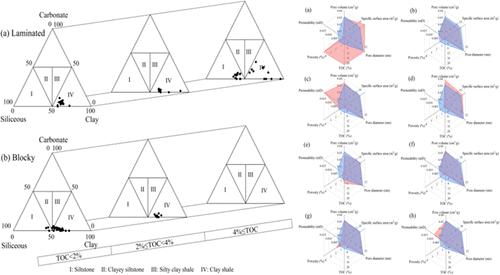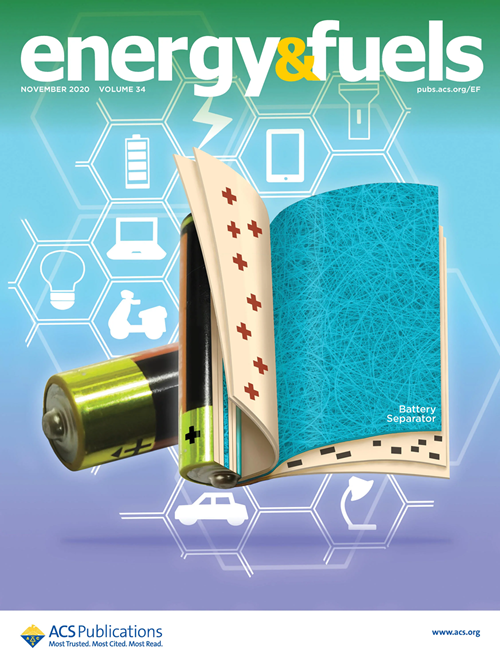Lithofacies and Its Reservoir Characteristics of Marine–Continental Transitional Shales: A Case Study of Shanxi Formation in Eastern Ordos Basin
IF 5.2
3区 工程技术
Q2 ENERGY & FUELS
引用次数: 0
Abstract
Marine–continental transitional shale is a significant target for shale gas exploration and development in China. However, current research on the lithofacies and the geological characteristics of these transitional shales is limited, constraining efficient exploration and development in the future. This study examines the S23 submember of the Permian Shanxi Formation in the Daning-Jixian area, which is located on the eastern margin of the Ordos Basin. To identify the various shale lithofacies types, we employed a series of experimental methods, including organic geochemistry, mineral composition analysis, thin-section identification, scanning electron microscopy, and gas adsorption, to systematically analyze the reservoir characteristics of these lithofacies. By integrating sedimentary structures, total organic carbon (TOC) content, and mineral components, we categorized the S23 submember shale into 24 distinct lithofacies, of which 8 types are dominated. They are laminated organic-rich clay shale, laminated organic-rich siltstone, laminated medium organic-rich clay shale, laminated organic-poor clay shale, blocky medium organic-rich clay shale, blocky organic-poor clay shale, blocky organic-poor silty clay shale, and blocky organic-poor siltstone. These lithofacies show considerable variations in reservoir development characteristics, with laminated organic-rich clay shale demonstrating superiority in TOC content, specific surface area, pore diameter, and porosity, thereby emerging as the optimal lithofacies for shale gas exploration and development.

海洋-大陆过渡页岩的岩性及其储层特征:鄂尔多斯盆地东部山西地层案例研究
海相大陆过渡页岩是中国页岩气勘探开发的重要目标。然而,目前对这些过渡页岩的岩性和地质特征的研究十分有限,制约了未来的有效勘探和开发。本研究考察了位于鄂尔多斯盆地东缘的大宁-吉县地区二叠系山西组 S23 亚元。为了识别各种页岩岩性类型,我们采用了有机地球化学、矿物成分分析、薄片鉴定、扫描电镜和气体吸附等一系列实验方法,系统分析了这些岩性的储层特征。通过整合沉积结构、总有机碳(TOC)含量和矿物成分,我们将 S23 亚元页岩划分为 24 个不同的岩相,其中 8 个岩相占主导地位。它们是层状富有机质粘土页岩、层状富有机质粉砂岩、层状中等富有机质粘土页岩、层状贫有机质粘土页岩、块状中等富有机质粘土页岩、块状贫有机质粘土页岩、块状贫有机质粉砂质粘土页岩和块状贫有机质粉砂岩。这些岩性在储层开发特征方面存在很大差异,其中层状富有机质粘土页岩在总有机碳含量、比表面积、孔隙直径和孔隙度方面表现优异,因此成为页岩气勘探和开发的最佳岩性。
本文章由计算机程序翻译,如有差异,请以英文原文为准。
求助全文
约1分钟内获得全文
求助全文
来源期刊

Energy & Fuels
工程技术-工程:化工
CiteScore
9.20
自引率
13.20%
发文量
1101
审稿时长
2.1 months
期刊介绍:
Energy & Fuels publishes reports of research in the technical area defined by the intersection of the disciplines of chemistry and chemical engineering and the application domain of non-nuclear energy and fuels. This includes research directed at the formation of, exploration for, and production of fossil fuels and biomass; the properties and structure or molecular composition of both raw fuels and refined products; the chemistry involved in the processing and utilization of fuels; fuel cells and their applications; and the analytical and instrumental techniques used in investigations of the foregoing areas.
 求助内容:
求助内容: 应助结果提醒方式:
应助结果提醒方式:


